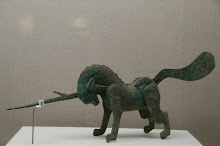21 students(4min +1min comments/per) presented their finding people and place around what we did in the last class_1.we picked up 7 below links.what students will do before next class(Feb.23,Monday):
- modify your people and place;
- group discussion and brainstorming(gaming:who+where+when+what+how)
- blog your people+place and concept design
hang it wall
(gaming:who+where+when+what+how)
==================================
group-1
许杨
宁远
黎花
袁铱
张印子
林若曦
--------------------------------------------------------------
who: 宅男; 自闭青年; 上进的心理障碍者;忧郁美少年;孤僻小孩;
where:家;电脑前; 心理咨询室;健身房; 窗前; 自己房间;
when: 深夜;一天24小时; 早餐时间; 白天; 清晨; 一整天;
what: 看动画;上网; 看医生; 做瑜伽; 伤春悲秋; 玩拼图;
how: 哀怨的;一人分饰两角的; 心有千千结的; 有氧运动缓解焦虑的;望着春雨; 一个人趴在地上;
---------------------------------------------------------------
who:单身青年;自大狂;单身老女人;单亲家庭中的儿子;失业潮人;
where:酒吧; 咖啡馆; 茶餐厅; 漂亮宝贝;SPA馆,健身房;游乐园;
when:午夜;午餐时;周末;情人节;party上;
what:参加派对;才艺表演;挣外快;打工;洗碗;玩psp;
how:打扮得光鲜亮丽;不修边幅(无人能认出)的;傲视一切;佯装everything is ok;自我释放压力;
-------------------------------------------------------------
who:幼儿园大班的小朋友;爱好篮球的男大生猿猿;公司白领安妮;家庭主妇;公务员;
where:海滩上;沙发上;电话亭;超市里;教堂;
when:下午放学;儿童节;晚饭后;早上5点;课间10分钟;下午茶时间;
what:买菜;倒立;折纸飞机;玩杀人游戏;复印文件;
how:和老朋友一起;精神极度放松的;有点厌倦的;亢奋的;辛苦的;
------------------------------------------------------------------
who:一个长沙的30“剩女”
where1:家
when:早上7点半或8点
what:化淡妆、穿衣出门(半小时)或(1小时)
how:一三五裙套,二四裤套的,以示其每日回家,非夜不归宿一族。在(台北豆浆买豆浆)或(肯德基早餐)。
where2:办公室
when:工作日的上午
what:工作,上网
how:傻傻的,精神焦虑的,面无表情的,心跳一下快一下慢的,准备收心开始工作的,收Email,回Email,打工作电话,填表。
where3:餐厅
when:午餐时间、晚上下班后
what:在公司楼下的餐厅吃(一品粥)或(盖码饭),在公司继续卖命当奴隶。晚上下班聚会
how:晚上,(露大腿)或(强行)打车,直奔(五一广场)或(芙蓉广场),跟四面八方的姐妹回合,晚餐吃(味千拉面)或(金牛角王),饭后(逛街)或(酒吧)。
where4:家
when:晚上10点后
what:看论坛,看影视剧
how:泡(天涯)或(猫扑),上床前用(迅雷)或(电驴)下一部电影看。如果失眠,就看三部。
-------------------------------------------------------------
1.宅男午夜打扮光鲜亮丽的出现在酒吧参加派对;
宅男午餐时傲视一切地在咖啡馆进行才艺表演;
宅男情人节时佯装没事在茶餐厅打工赚外快;
宅男周末哀怨的去游乐园自我释放压力;
2.失业潮人大白天去心理咨询室向医生倾诉烦恼;
失业潮人整天躲在自己房间趴在地上玩拼图游戏;
失业潮人清晨起来站在窗前望着雨点伤春悲秋;
失业潮人深夜在家不修边幅的在BBS上灌水;
3.单身老女人白天傻傻的在健身房做瑜伽缓解焦虑;
单身老女人深夜精神焦虑的在家上网看动画;
4.孤僻小孩早上7点半面无表情的去肯德基吃早餐;
5.单亲家庭的儿子整夜失眠心跳一下快一下慢的看影视剧;
6.“剩女”周末准备收心开始工作的去漂亮宝贝改变形象;
7.爱好篮球的男大生猿猿有点厌倦的课间十分钟在操场倒立;
8.幼儿园大班的小朋友晚饭后在窗前辛苦的折纸飞机;
9.公务员下午茶时间精神放松的在沙发上看影视剧;
10.儿童节公司白领安妮和朋友一起在海滩上玩杀人游戏;
11.上进的心理障碍者早上5点亢奋的穿衣出门(半小时)或(1小时) ;
12.情人节自大狂不修边幅(无人能认出)的在公司继续卖命当奴隶;
13.忧郁美少年中午佯装everything is ok的在公司楼下的餐厅吃(一品粥)或(盖码饭) ;
14.单亲家庭中的儿子心有千千结的晚上10点后在家化淡妆;
15. 自闭青年工作日的上午在游乐园一人分饰两角的玩psp。
=====================================
group-2
付宠光
李 涛
王 成
徐盛超
杨琛成
杨华军





---------------------------------------------------------
付磊,刘静,傅婕,赵邦耀,陶烨,汪晓丹,罗清雅,尼玛玉珍
--------------------------------------------------------------
who:游戏公司小职员,总带着耳机的DJ,可爱的高中男生
when:晚上下班以后,外出会朋友时,上学路上
where:在地铁上,车站里
how:手舞足蹈,眉飞色舞的,默默地,左顾右盼的
what:听MP3,打游戏机,看美女发呆,
--------------------------------------------------------------
刘静
who:陈爷爷,独自居住的王奶奶,一个人住的李爷爷
when:早上9点,深夜,
where:超市,家里,电信局
how:努力看清条码的价, 很痛苦,需要急救 人多,心烦
what:买菜,摔倒了,交电话费
-------------------------------------------------------------
傅婕
WHO: 聋哑人
WHEN: 深夜,清晨,节假日
WHERE: 家中,食堂
HOW: 满怀热情的,孤独的,忧愁的WHAT: 搞摄影创作,胡思乱想,打电动
-------------------------------------------------------------
赵邦耀
Who:待业青年,购物狂,公司高管
When:午夜子时,月底发工资时,午休时
Where:公园里,潮流特区,咖啡吧
How: 若有所思的,歇斯底里的,匆忙的
-------------------------------------------------------------
陶烨
who:刚谈妥一笔大生意的总裁助理
where1:学校办公室
when:下午6点
what:解决儿子被学校记大过的问题
how:一边教育儿子,一边向老师求情
who2:销售主管
where2:公司会议室
when:一月份的某日上午
what:与设计部主任讨论并决定产品方案
how:以类似于激烈辩论赛的方式
where3:俄罗斯
when:寒冷雪天
what:考察地区市场潜力
how:市场调研:客户需求调查,相关产品调查,经济潜力调查等等
------------------------------------------------
汪晓丹
Who: 37岁的家庭主妇
when: 深夜12点
where: 楼上邻居家
what: 跟几个师奶打麻将
how: 一边打哈欠 一边聊天
when: 早上6—7点
where: 菜市场
what: 买菜
how: 讨价还价,斤斤计较
when: 季末的下午
where: 商场
what: 买打折商品
how: 万里选一,吹毛求疵
-------------------------------------------------------------
罗清雅
Who 小学生
When 中午放学 周末放假 晚上
Where 学校 商场 家
How 蹲在某个角落泪水欲出的 疯狂乱跑,失措的 无头绪的抓狂的
What 等待父母 迷路,寻找家人,警察叔叔或电话亭 做功课
-------------------------------------------------------------
尼玛玉珍
Who:高中生
Where:学校
When:校园文化节 校园文艺晚会 班级Party
What: 跳街舞 演Rap
How: 帅气的 so cool滴```前卫的
-------------------------------------------------------------
哈立玛:
Who: 弱智儿童
Where:医院
When:早上
What: 接受治疗
How: 不断挣扎的
----------------------------------------------
最后我们得到了这些有趣的组合:
1,深夜12点,待业青年在地铁上无头绪,抓狂地等待父母
2,深夜12点,购物狂在车站里蹲在某个角落,泪水与出的做功课
3,午夜子时,聋哑人在超市打电动,一边聊天,一边打哈欠
4,刚谈妥一笔生意的总裁助理在午休时去超市满怀激情地打电动
5,被同学们称为“潮人王”的陈爷爷在节假日去商场约会
6,孤独的陈爷爷在清晨去大自然幻想
7,游戏公司小职员商务九点半在菜市场手舞足蹈眉飞色舞的摔倒了
8,一个人住的李爷爷深夜里在地铁上五种选一的看美女发呆
9,37岁身体刚刚走形的家庭主妇贺阿姨外出会朋友时在礼堂心烦的跳街舞
10,师奶在深夜结伴去电信局吹毛求疵,求最低价地买打折商品。
11,陈爷爷在周末放假时在家里匆忙地幻想。
12,一个人住的李爷爷在月底发工资后在商场里讨价还价地等待父
13,小学生在寒冷的大雪天在公园里孤独地等待父母。
14,独自居住的王奶奶清晨在商场忧郁地买菜。
15,小学生深夜12点在家中边聊天,边打哈欠看美女发呆。
16,陈爷爷早上9:00在商场手舞足蹈的跳街舞
17,高中生外出到楼上邻居家会朋友,在手舞足蹈、眉飞色舞的摄影创作
18,高中生晚上下班后在学校办公室默默的等待父母
19,寒冷的大雪天,游戏公司小职员去菜市场吹毛求疵,万里选一的考察市场潜力
20,总带着耳机的DJ在下午6点的俄罗斯讨价还价,斤斤计较的与设计部主任讨论方案问题
21,1月份的某日上午,游戏公司小职员在菜市场吹毛求疵的给儿子记大过
22,销售主管晚上在家里进行了一次杀了两毛钱的价,走时a走了2根大葱的胡思乱想。
23,待业青年下午在菜市场酷酷的演rap。
24,高中生深夜在车站里和几个师奶蹲在某个角度,泪水溅出的搓麻将。
25,游戏公司小职员深夜蹲在电信局的某个角落,泪水欲出地与设计部主任讨论方案。
26,游戏公司小职员深夜蹲在电信的某个角落泪水欲出的教育儿子。。。
27,周末放假,眉飞色舞的公司高管在食堂买菜。
28,高中生在校园文化节的商场里酷的考察地区市场潜力。
29,待业青年深夜十二点去食堂需要急救的交电话费。(食堂的充钱机器?)
30,在节日的下午聋哑人在公司的会议室歇斯底里的乱想。
============================================
田兴富\ 康乐\黄一三\梁奇
------------------------------------------------------
康乐
Who: division managers 部门经理
When: lunch break 午餐时间
Where: in the office. 办公室
How: asking takeaways. 外卖服务
What: having lunch in the office.' 在办公室午餐
黄一三
WHO: 在校大学生
WHEN: 周日
WHERE:公交车上
HOW: 看电视
WHAT: 坐车
梁奇
Who: 已步入IT业三年的28岁未婚男性
When: 周一至周六的上班乘车时间
Where: 上班 乘坐的地铁(广州、上海)
How: 闲来无聊的坐着
What: 玩PSP,看报刊
田兴富:
Who: 在外打工的民工
When: 晚8~9点 下班后
Where: 自己租的房子
How: 使用手机
What: 给远方的亲人打电话
------------------------------------------------------------------------------
我们得到的比较合理的句子:
1, 在校大学生晚上8~9点下班后,仍然在办公室,闲来无聊的坐着,玩PSP,看报刊。
2, 在校大学生周一至周六的上班乘车时间,在上班乘坐的地铁上,一边叫外卖,一边给远方的亲人打电话。
3, 在校大学生于午餐时间,闲来无聊的坐在上班乘坐的地铁上坐车。
4, 在校大学生周一至周六的上班乘车时间,在自己租的房子里使用手机玩PSP,看报刊。
5, 在校大学生午餐时间上班乘坐的地铁上,使用手机玩PSP,看报刊。
6, 在校大学生周一至周六的上班乘车时间,在公交车上使用手机给远方的亲人打电话。
7, 在校大学生周日,在自己租的房子里,闲来无聊的坐着,给远方的亲人打电话。
8, 已步入IT业三年的28岁未婚男性,午餐时间在公交车上叫外卖,并在办公室午餐。
9, 已步入IT业三年的28岁未婚男性,晚8~9点 下班后,在自己租的房子里,一边看电视,一边想着坐车。
10, 已步入IT业三年的28岁未婚男性,晚8~9点 下班后在自己租的房子里,一边看电视,一边想着坐车。
11, 已步入IT业三年的28岁未婚男性,晚8~9点 下班后在公交车上,使用手机给远方的亲人打电话。
12, 已步入IT业三年的28岁未婚男性,周一至周六的上班乘车时间,在上班乘坐的地铁上,使用手机玩PSP,看报刊。
13, 已步入IT业三年的28岁未婚男性,晚8~9点 下班后在自己租的房子里,闲来无聊的坐着玩PSP,看报刊。
14, 部门经理晚上8~9点下班后,仍然在办公室,闲来无聊的坐着,玩PSP,看报刊。
15, 部门经理周日在自己租的房子里,闲来无聊的坐着给远方的亲人打电话。
16, 部门经理午餐时间上班 乘坐的地铁上,一边看电视一边给远方的亲人打电话。
17, 部门经理周一至周六的上班乘车时间,在公交车上闲来无聊的坐着,玩PSP,看报刊。
18, 部门经理晚8~9点 下班后,自己租的房子里,闲来无聊的坐着,玩PSP,看报刊。
19, 部门经理周一至周六的上班乘车时间,在公交车上叫外卖,然后在办公室午餐。
20, 在外打工的民工周一至周六的上班乘车时间,公交车上使用手机给远方的亲人打电话。
21, 在外打工的民工晚8~9点 下班后上班乘坐的地铁上看电视,玩PSP,看报刊。
22, 在外打工的民工午餐时间在公交车上使用手机在办公室午餐。
23, 在外打工的民工晚8~9点 下班后,在公交车上闲来无聊的坐着玩PSP,看报刊。
24, 在外打工的民工晚8~9点 下班后在上班乘坐的地铁上使用手机给远方的亲人打电话。
25, 在外打工的民工周日,在办公室看电视,准备去坐车。
26, 在外打工的民工午餐时间,在办公室看电视午餐。
===============================================================









































